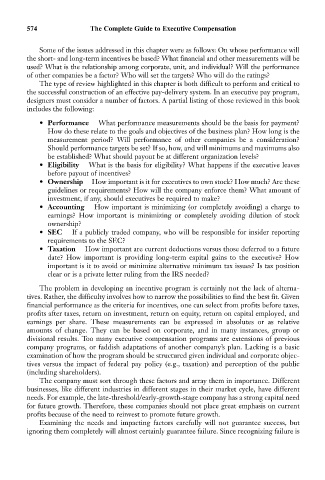Page 588 - Bruce Ellig - The Complete Guide to Executive Compensation (2007)
P. 588
574 The Complete Guide to Executive Compensation
Some of the issues addressed in this chapter were as follows: On whose performance will
the short- and long-term incentives be based? What financial and other measurements will be
used? What is the relationship among corporate, unit, and individual? Will the performance
of other companies be a factor? Who will set the targets? Who will do the ratings?
The type of review highlighted in this chapter is both difficult to perform and critical to
the successful construction of an effective pay-delivery system. In an executive pay program,
designers must consider a number of factors. A partial listing of those reviewed in this book
includes the following:
• Performance What performance measurements should be the basis for payment?
How do these relate to the goals and objectives of the business plan? How long is the
measurement period? Will performance of other companies be a consideration?
Should performance targets be set? If so, how, and will minimums and maximums also
be established? What should payout be at different organization levels?
• Eligibility What is the basis for eligibility? What happens if the executive leaves
before payout of incentives?
• Ownership How important is it for executives to own stock? How much? Are these
guidelines or requirements? How will the company enforce them? What amount of
investment, if any, should executives be required to make?
• Accounting How important is minimizing (or completely avoiding) a charge to
earnings? How important is minimizing or completely avoiding dilution of stock
ownership?
• SEC If a publicly traded company, who will be responsible for insider reporting
requirements to the SEC?
• Taxation How important are current deductions versus those deferred to a future
date? How important is providing long-term capital gains to the executive? How
important is it to avoid or minimize alternative minimum tax issues? Is tax position
clear or is a private letter ruling from the IRS needed?
The problem in developing an incentive program is certainly not the lack of alterna-
tives. Rather, the difficulty involves how to narrow the possibilities to find the best fit. Given
financial performance as the criteria for incentives, one can select from profits before taxes,
profits after taxes, return on investment, return on equity, return on capital employed, and
earnings per share. These measurements can be expressed in absolutes or as relative
amounts of change. They can be based on corporate, and in many instances, group or
divisional results. Too many executive compensation programs are extensions of previous
company programs, or faddish adaptations of another company’s plan. Lacking is a basic
examination of how the program should be structured given individual and corporate objec-
tives versus the impact of federal pay policy (e.g., taxation) and perception of the public
(including shareholders).
The company must sort through these factors and array them in importance. Different
businesses, like different industries in different stages in their market cycle, have different
needs. For example, the late-threshold/early-growth-stage company has a strong capital need
for future growth. Therefore, these companies should not place great emphasis on current
profits because of the need to reinvest to promote future growth.
Examining the needs and impacting factors carefully will not guarantee success, but
ignoring them completely will almost certainly guarantee failure. Since recognizing failure is

